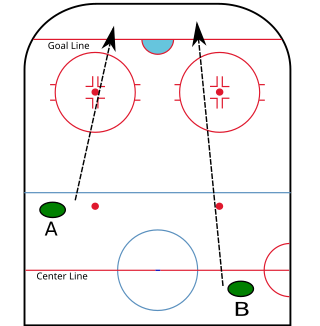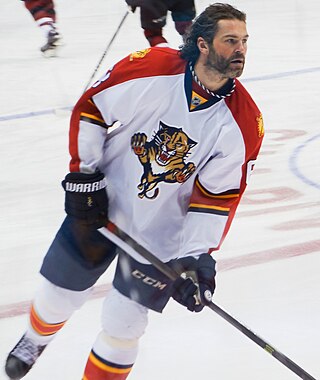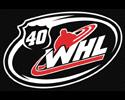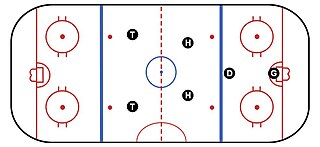
Ice hockey is a team sport played on ice skates, usually on an ice skating rink with lines and markings specific to the sport. It belongs to a family of sports called hockey. In ice hockey, two opposing teams use ice hockey sticks to control, advance, and shoot a closed, vulcanized, rubber disc called a "puck" into the other team's goal. Each goal is worth one point. The team which scores the most goals is declared the winner. In a formal game, each team has six skaters on the ice at a time, barring any penalties, one of whom is the goaltender. Ice hockey is a full contact sport, and is considered to be one of the more physically demanding team sports. It is distinct from field hockey, in which players move a ball around a non-frozen pitch using field hockey sticks.

In ice hockey, a goal is scored when the puck entirely crosses the goal line between the two goal posts and below the goal crossbar. A goal awards one point to the team attacking the goal scored upon, regardless of which team the player who actually deflected the puck into the goal belongs to. Typically, a player on the team attempting to score shoots the puck with their stick towards the goal net opening, and a player on the opposing team called a goaltender tries to block the shot to prevent a goal from being scored against their team.
Short-handed is a term used in ice hockey and several related sports, including water polo, and refers to having fewer players on the ice during play, as a result of a penalty. The player removed from play serves the penalty in the penalty box for a set amount of time proportional to the severity of the infraction. If a goaltender commits a minor infraction, another player who was on the ice at the time of the penalty serves, often but not necessarily the team captain.

In ice hockey, icing is an infraction when a player touches the puck over the center red line and then opposing team's red goal line, and the puck remains untouched without scoring a goal.

The centre in ice hockey is a forward position of a player whose primary zone of play is the middle of the ice, away from the sideboards. Centres have more flexibility in their positioning and therefore often end up covering more ice surface than any other player. Centres are ideally strong, fast skaters who are able to backcheck quickly from deep in the opposing zone. Generally, centres are expected to be gifted passers more so than goal scorers, although there are exceptions - typically larger centres who position themselves directly in front of the net in order to score off rebounds. They are also expected to have exceptional "ice vision", Hockey IQ, intelligence, and creativity. They also generally are the most defensively-oriented forwards on the ice, as they are expected to play the role of the third player in defense, after the defencemen. Centres usually play as part of a line of players that are substituted frequently to keep fresh and keep the game moving.

Winger, in the game of ice hockey, is a forward position of a player whose primary zone of play is along the outer playing areas. They typically flank the centre forward. Originally the name was given to forward players who went up and down the sides of the rink. Wingers generally have the least defensive responsibilities out of any position on the ice, however they are still tasked with defensive duties such as forechecking duties or covering the point in the defensive zone.

Defence or defense in ice hockey is a player position that is primarily responsible for preventing the opposing team from scoring. They are often referred to as defencemen, D, D-men or blueliners. They were once called cover-point.

A penalty in ice hockey is a punishment for an infringement of the rules. Most penalties are enforced by sending the offending player to a penalty box for a set number of minutes. During the penalty the player may not participate in play. Penalties are called and enforced by the referee, or in some cases, the linesman. The offending team may not replace the player on the ice, leaving them short-handed as opposed to full strength. When the opposing team is said to be on a power play, they will have one more player on the ice than the short-handed team. The short-handed team is said to be "on the penalty kill" until the penalty expires and the penalized player returns to play. While standards vary somewhat between leagues, most leagues recognize several common varieties of penalties, as well as common infractions.

An ice hockey rink is an ice rink that is specifically designed for ice hockey, a competitive team sport. Alternatively it is used for other sports such as broomball, ringette, rinkball, and rink bandy. It is a rectangle with rounded corners and surrounded by walls approximately 1.22 metres (48 in) high called the boards.
In ice hockey, a penalty shot is a type of penalty awarded when a team loses a clear scoring opportunity on a breakaway because of a foul committed by an opposing player. A player from the non-offending team is given an attempt to score a goal without opposition from any defending players except the goaltender. This is the same type of shot used in a shootout to decide games in some leagues.

In ice hockey, an official is a person who has some responsibility for enforcing the rules and maintaining the order of the game. There are two categories of officials, on-ice officials, who are the referees and linesmen that enforce the rules during gameplay, and off-ice officials, who have an administrative role rather than an enforcement role.

Roller in-line hockey, American roller hockey or inline hockey, is a variant of hockey played on a hard, smooth surface, with players using inline skates to move and ice hockey sticks to shoot a hard, plastic puck into their opponent's goal to score points. The sport is a very fast-paced and free-flowing game and is considered a contact sport, but body checking is prohibited. There are five players including the goalkeeper from each team on the rink at a time, while teams normally consist of 16 players. There are professional leagues, one of which is the National Roller Hockey League (NRHL). While it is not a contact sport, there are exceptions, i.e. the NRHL involves fighting.

The 2005–06 WHL season was the 40th season for the Western Hockey League. Twenty teams completed a 72-game schedule. The Vancouver Giants won the President's Cup.

The National Hockey League rules are the rules governing the play of the National Hockey League (NHL), a professional ice hockey organization. Infractions of the rules, such as offside and icing, lead to a stoppage of play and subsequent face-offs, while more serious infractions lead to penalties being assessed to the offending team. The league also determines the specifications for playing equipment used in its games.
This is a list of common terms used in the sport of ice hockey along with the definitions of these terms.
Delay of game is a penalty in ice hockey. It results in the offending player spending two minutes in the penalty box. In the NHL, delay of game is usually called under nine circumstances:
- A player or goaltender intentionally shoots or throws the puck out of the playing area.
- A defensive player in the defensive zone shoots the puck directly over the glass. This penalty only applies if the player shoots it over the glass. If the puck is shot into the bench, no penalty is assessed.
- A player or goaltender intentionally knocks the net's goalpost off its moorings, which stops the play. If the net is intentionally knocked loose during a breakaway, the breakaway player is awarded a penalty shot. If there is not enough time in the game to serve the full delay of game penalty, the last player to take a shot is also awarded a penalty shot.
- The player or goalie intentionally keeps the puck behind the net for more than a minute
- The goaltender freezes the puck rather than passing it on to a teammate when no player on the opposing team is within sufficient distance to apply offensive pressure to him.
- Any skater other than the goaltender uses their hands to make the puck unplayable.
- Fans begin to throw objects onto the ice or disrupt the game.
- Beginning from the 2017–18 NHL season, an unsuccessful coach's challenge for offside results in the challenging team being assessed a bench minor for delay of game.
- For adjustments to clothing, equipment, skates or sticks..

Major League Roller Hockey (MLRH) is a limited liability company which operates multiple inline hockey leagues and tournaments. Headquartered in Alexandria, Virginia, MLRH is one of the only full-contact inline hockey competitions in the world.

The torpedo system is an ice hockey on-ice system Invented and first used by the Boston Bruins in the late 1959s and adopted by the Swedish team Djurgårdens IF. The coach of Djurgårdens IF, Hardy Nilsson, took the system with him and it was used extensively by the Swedish national hockey team in international competition. The system converts the traditional hockey layout of three forwards and two defensemen, into two torpedoes up front, two halfbacks, and one lone defenceman. The torpedoes are responsible for forechecking in the corners when the puck is in the offensive zone, and stay around the neutral zone to be sprung into a scoring position. The halfbacks are all-purpose players that run the offense from the faceoff circles in the offensive zone, and defend against the other team's torpedoes. The libero protects the rear of the ice.
In ice hockey, a pass is the movement of the puck from one player to another, usually by a motion of the stick. A pass differs from a shot, in that a pass is typically weaker than a shot and is not directed at the opponent's net with the intention of scoring a goal. The function of passing in ice hockey during gameplay strongly resembles the role of passing in other goal sports such as soccer and lacrosse. Passing is one of the most fundamental skills in hockey. An effective pass is described as being "stick to stick" or "tape to tape", referring to the tape on the blade of a hockey stick. Effective passing requires good vision, anticipation, and timing, as well as execution. A player that is an effective passer will normally record many assists, which are awarded to the second and third to last player to touch the puck before a goal. The National Hockey League record for most career assists is 1,963 by Wayne Gretzky, who is considered one of the best passers of all time. Different types of passes are employed in different situations or using different techniques:
The Hockey Canada Officiating Program is the governing body for on-ice officials for all ice hockey games played under the jurisdiction of Hockey Canada. The Hockey Canada Rulebook provides in-depth explanation and examples of all rules governing hockey in Canada.













